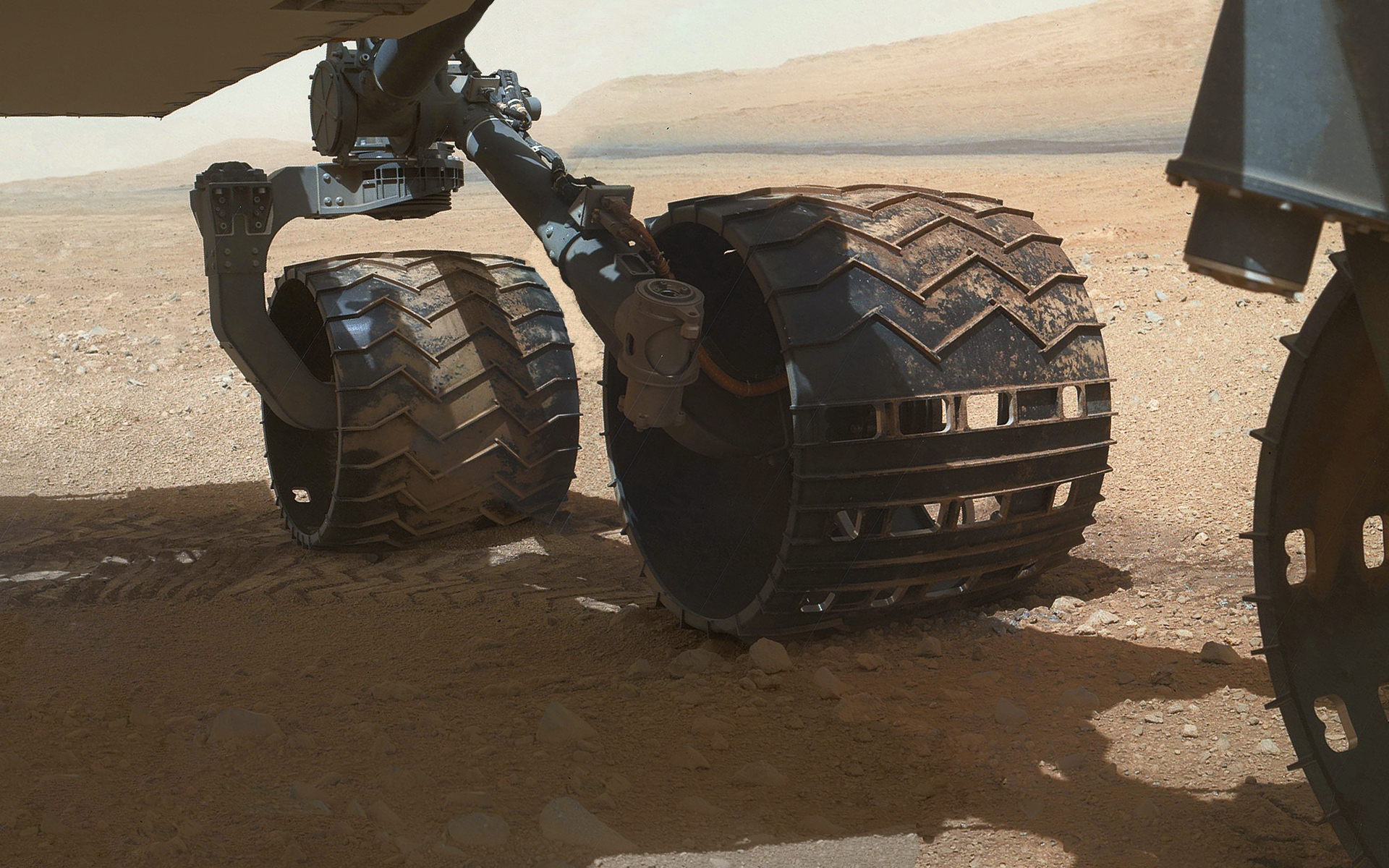Mars's life-friendly past just got friendlier. Using samples previously collected by the NASA rover Curiosity, scientists have discovered evidence of nitrates in Martian rock: nitrogen compounds that on Earth are a crucial source of nutrients for living things.
The findings, published in the journal Proceedings of the National Academy of Sciences, lend further support to the idea that the Red Planet, now barren and dry, could once have hosted habitable environments.
Although planetary scientists have been on the hunt for organic carbon – the type of carbon-containing molecules that could be used and produced by living things – nitrogen also plays an essential role in life as we know it, said lead author Jennifer Stern, a planetary geochemist at NASA Goddard Space Flight Center in Greenbelt, Md.
For example, nitrogen is a key component of nucleobases that make up RNA and DNA, and of amino acids, the building blocks of proteins.
“People want to follow the carbon, but in many ways nitrogen is just as important a nutrient for life,” said Stern, a science team member for the Mars Science Laboratory mission, as Curiosity’s mission is formally known. “Life runs on nitrogen as much as it runs on carbon.”
So the scientists examined data from three samples processed by the Sample Analysis at Mars, or SAM, instrument, which is part of a formidable laboratory in Curiosity’s belly. They looked at samples pulled from three spots near its landing site: aeolian deposits from Rocknest and mudstone deposits from John Klein and Cumberland.
These sites were all visited during a detour from Curiosity’s main mission, which was to drive to Mt. Sharp, the 3-mile-high mound in the middle of Gale Crater whose clay-rich layers looked like an ideal spot to search for signs of past habitable environments. Going off course was a risk, but it paid off; the John Klein and Cumberland mudstones have previously turned up a smorgasbord of chemicals and water-altered minerals that would have made it a potentially prime place for life, if it ever existed on the Red Planet. Now, this fresh analysis of the nitrogen compounds in these rocks further strengthens that idea.
The rock samples were cooked in SAM’s oven and the resulting gases were analyzed. The researchers found a significant amount of nitric oxide, a compound that, before it was cooked, probably came from nitrates, Stern said.
“What we’re detecting is nitric oxide, but we know from lab experiments that when we heat up nitrates, they break down in a predictable way,” Stern said. “And that’s why we think these are nitrates.”
The researchers had to carefully subtract out the amount of contamination that would be coming from the rover itself, to make sure they were not getting a false signal.
When they finished, they were still left with a significant amount of nitrogen – enough to account for 110 to 300 parts per million of nitrate in the Rocknest sample, 70 to 260 parts per million in John Klein and 330 to 1,100 parts per million in Cumberland. That’s comparable to the amount of nitrates you’d get in extremely dry places on Earth, such as the Atacama Desert in South America.
Nitrates are important molecules because it's easier for living things to access nitrogen and put it to work, Stern said. Nitrogen in the atmosphere is typically made of two nitrogen molecules that are triple-bonded to each other, making it a tough molecule to cut apart. Nitrates consist of a nitrogen linked to three oxygen atoms with only single or double bonds, and are much easier to disassemble.
Most nitrates on Earth are produced by living things, Stern said. But in the case of Mars, the team believes the nitrates were created during a “thermal shock,” such as a lightning strike or an asteroid impact.
Among the next steps, she says, is to see whether whatever process that generated these nitrates is still happening on Mars.
“We’re going to try to understand whether this process is still happening today at all,” Stern said, “or whether this all happened in the past in a different Mars, in a different climate regime, in a different atmosphere.”
The findings, published in the journal Proceedings of the National Academy of Sciences, lend further support to the idea that the Red Planet, now barren and dry, could once have hosted habitable environments.
Although planetary scientists have been on the hunt for organic carbon – the type of carbon-containing molecules that could be used and produced by living things – nitrogen also plays an essential role in life as we know it, said lead author Jennifer Stern, a planetary geochemist at NASA Goddard Space Flight Center in Greenbelt, Md.
For example, nitrogen is a key component of nucleobases that make up RNA and DNA, and of amino acids, the building blocks of proteins.
“People want to follow the carbon, but in many ways nitrogen is just as important a nutrient for life,” said Stern, a science team member for the Mars Science Laboratory mission, as Curiosity’s mission is formally known. “Life runs on nitrogen as much as it runs on carbon.”
So the scientists examined data from three samples processed by the Sample Analysis at Mars, or SAM, instrument, which is part of a formidable laboratory in Curiosity’s belly. They looked at samples pulled from three spots near its landing site: aeolian deposits from Rocknest and mudstone deposits from John Klein and Cumberland.
These sites were all visited during a detour from Curiosity’s main mission, which was to drive to Mt. Sharp, the 3-mile-high mound in the middle of Gale Crater whose clay-rich layers looked like an ideal spot to search for signs of past habitable environments. Going off course was a risk, but it paid off; the John Klein and Cumberland mudstones have previously turned up a smorgasbord of chemicals and water-altered minerals that would have made it a potentially prime place for life, if it ever existed on the Red Planet. Now, this fresh analysis of the nitrogen compounds in these rocks further strengthens that idea.
The rock samples were cooked in SAM’s oven and the resulting gases were analyzed. The researchers found a significant amount of nitric oxide, a compound that, before it was cooked, probably came from nitrates, Stern said.
“What we’re detecting is nitric oxide, but we know from lab experiments that when we heat up nitrates, they break down in a predictable way,” Stern said. “And that’s why we think these are nitrates.”
The researchers had to carefully subtract out the amount of contamination that would be coming from the rover itself, to make sure they were not getting a false signal.
When they finished, they were still left with a significant amount of nitrogen – enough to account for 110 to 300 parts per million of nitrate in the Rocknest sample, 70 to 260 parts per million in John Klein and 330 to 1,100 parts per million in Cumberland. That’s comparable to the amount of nitrates you’d get in extremely dry places on Earth, such as the Atacama Desert in South America.
Nitrates are important molecules because it's easier for living things to access nitrogen and put it to work, Stern said. Nitrogen in the atmosphere is typically made of two nitrogen molecules that are triple-bonded to each other, making it a tough molecule to cut apart. Nitrates consist of a nitrogen linked to three oxygen atoms with only single or double bonds, and are much easier to disassemble.
Most nitrates on Earth are produced by living things, Stern said. But in the case of Mars, the team believes the nitrates were created during a “thermal shock,” such as a lightning strike or an asteroid impact.
Among the next steps, she says, is to see whether whatever process that generated these nitrates is still happening on Mars.
“We’re going to try to understand whether this process is still happening today at all,” Stern said, “or whether this all happened in the past in a different Mars, in a different climate regime, in a different atmosphere.”
http://www.latimes.com/


No comments:
Post a Comment